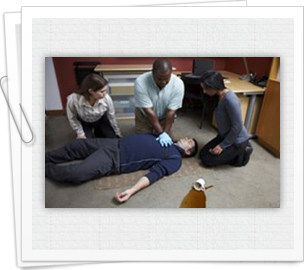Online CPR Certification Blog
Witnessing CPR helps
Date: September 24th, 2013
 How family bystanders coped when witnessing CPR
How family bystanders coped when witnessing CPR
Relatives are more likely to take in the idea of a losing a loved one should they be present at the scene when the CPR is being performed. A lot of people who are present when a CPR procedure is being performed to resuscitate a loved one are said to be better off. This is mainly because they’ll at least have the ability to take in the thought of having lost a loved one should the procedure fail. It’s not the same perception for people who might not have been present as they are said to often struggle with the death of their family member.
Furthermore, research shows that family members present aren’t likely to undergo through anxiety depression or PSTD (Post-traumatic stress disorder). They are able to handle the situation better as compared to those who weren’t irrespective of the outcome.
Performed in France, the study also shows that the witnesses in no way affected the rate of survival or performance of the team administering the procedure. In a considerable number of cases, the family members present also didn’t affect number of legal claims after the procedure.
Dr. Stephen Borron, a director of a medical program in Texas, said that the study looked a phenomenon that had been controversial for some time. He further added that he was indeed surprised by the fact that stress among medical staff wasn’t as great as initially perceived. The doctor argued that the study failed to reflect the opinion of physicians who are of the belief that stress levels might be higher in a room where relatives are present.
In industrialized countries, cardiac arrest is believed to claim over 600,000 deaths annually. 4% of subjects in study lived past a month after CPR procedure. 80% of abrupt attacks happen away from the hospital. According to other papers, 60% of elderly people who suffered from cardiac arrest while at a hospital setting lived for another year.
The doctor sampled 570 family members of patients who had CPR administered on them by medical emergency service units in France.
Overlooked assumptions shedding light on procedural CPR
8 out of every ten family members opted to stay when issued with the chance to witness the procedure. 60% of family members who opted out of the chance showed symptoms that were similar in nature to PSTD. This was followed by other related symptoms such as depression and anxiety.
According to Borron, lack of PSTD in relatives who witnessed the procedure could all be attributed to the fact that they had witnessed all effectives attempt made. It could have been an opportunity for them to also say their last goodbye.
Downar, an assistant professor at Toronto University, is believes that a normal resuscitation for hospital cardiac arrest victims includes shocking, usage of catheter and inserting breathing tubes. To him such a scenario can look primitive, bloody and even unpleasant to some extent.
Mr. Downar presented a case that advised against having relatives present during CPR administration in hospital settings. He applauded Borron’s study saying that it was both practical and bright. He however cited that hospital environment might offer unpleasant scenes that might be too much for the family members to take.
In conclusion, Borron warned that people needed to pay keen attention in the different medical systems which vary from one country to another. To him, the environment in France could be different from his thus the diversity in perceptions.